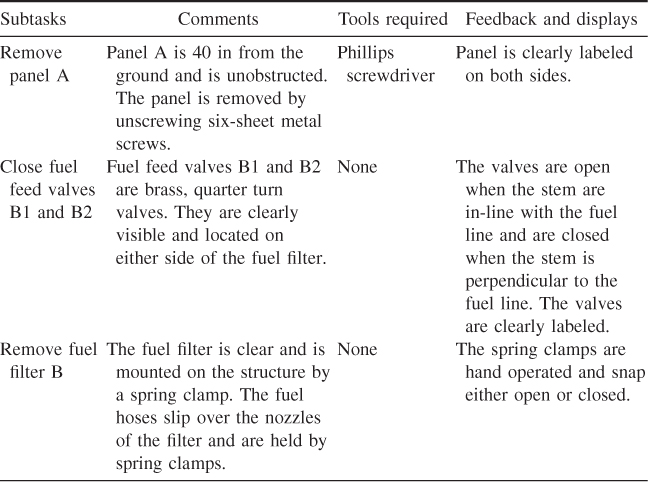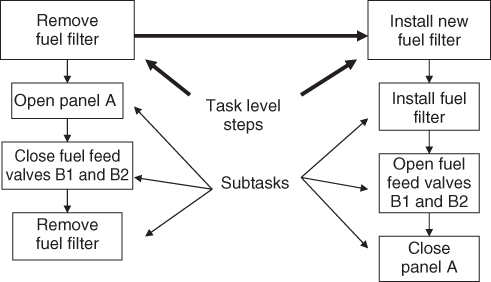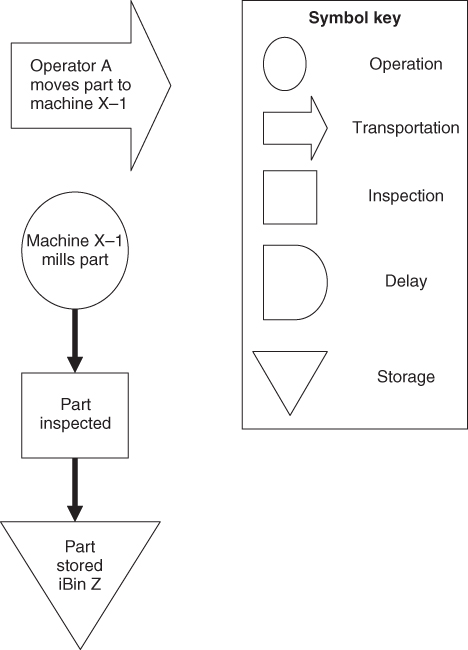5.4 Task Analysis Process
There are hundreds of task analysis techniques with advantages and disadvantages; therefore, you may want to use a mix of task analysis methods during your assessment process.
5.4.1 Step 1: Data Collection Information
Identifying the focus of the analysis helps in deciding what type of information should be collected and how it should be gathered. Focus on the system and what the results will be used for, such as in the design of a new system, modifying an existing system, or developing training.
Develop a list of tasks and positions associated with the overall job. Provide descriptions of each task that characterize the task according to issues of potential importance to the system, process, or job. How complex the system may be and the eventual application of the results will determine the level of analysis to be performed.
A system is composed of a job or jobs that ultimately lead to a common goal. Those jobs can be broken into tasks that must be performed in order to complete the job. The tasks can then be broken down into steps or what is referred to as subtasks. Those steps need to be performed in order to accomplish the overall task. Each task or subtask can be defined differently depending on the application. It is very important that consistency be applied within a given analysis.
Table 5.1 lists the types of information that might be required in order to complete a job.
Table 5.1 Required Types of Information
| Task information |
| Identify tasks involved in the process, system, or training |
| Identify subtasks involved in the tasks |
| Group and organize the subtasks involved in a task |
| Identify which subtasks have commonalities and are linked to each other |
| Identify the priority based on the criticality of the subtasks |
| Identify how frequently the subtasks occur under different conditions |
| Identify the sequence of the subtasks, depending on the occurrence |
| Identify which subtasks should be executed based on the event or a decision made in a previous subtask or even task |
| Identify the goals or objectives for each subtask |
| Identify the knowledge the user has on how the system functions (i.e., tasks, subtasks) |
Earlier we talked about the design and the analysis process as being iterative. The data collected concerning the job and the tasks are broken down into subtasks, and once reviewed, it might be necessary to collect more details and information.
5.4.2 Step 2: Recording the Data
Some of the methods for collecting information in a task analysis are shown in Table 5.2.
Table 5.2 Methods of Collecting Information
| Data collection methods |
| Observe and record information on the worker(s) performing the job. This can be done as job shadowing or just taking notes as the worker (s) complete their duties. |
| Interview the worker(s) by asking questions about their job. These questions can be open-ended questions or specific questions related to the specific task. The best way to collect this information is to allow the worker(s) to remain anonymous. This helps them to be more honest, knowing the management will not be able to identify them specifically. |
| Review existing documentation such as standard operating procedures (SOPs), safety and injury reports, training manuals, and any other previous surveys or analyses. |
| Checklists may be used to identify workplace concerns, human system interfaces, ergonomics issues, environmental issues, and any other workplace concerns. |
| Surveys or questionnaires may be used to collect the worker(s) views of the system or tasks. |
| Videotape or record the worker(s) performing the job or specific tasks involved in completing the job. |
Document the information gathered utilizing the methods suggested in Table 5.2. The data needs to be compiled in a format that could be used to analyze and process the information. A simple and straightforward format that can be used to organize and record the collected data is a column format (Table 5.3).
Table 5.3 Examples of Data Recording

Other examples of formats are hierarchical diagrams, operational sequence diagrams, and timelines. Breaking down the tasks into subtasks can be accomplished by the use of a hierarchical format. The general tasks are listed at the top of the diagram. Detailed subtasks that comprise each task are illustrated by branching off from the appropriate task box (Fig. 5.1).
Figure 5.1 Hierarchical task analysis diagram.

Timelines are used to define not only the sequence of steps that make up the task but also the time that they occur and duration. This presentation is particularly useful when there are several workers and machines interacting and can help to identify when the worker and/or machines are being overloaded or under loaded during the completion of a task (Fig. 5.2).
Figure 5.2 Time line.

The use of operational sequence diagrams shows the sequence of steps and the relationships between them in completing the task. This method requires making a flow chart of the task using standard symbols to present the information (Fig. 5.3). Note the example provided is very basic.
Figure 5.3 Operational sequence diagram.

5.4.3 Step 3: Data Analysis
There are many ways to use the data obtained from task analyses. Table 5.4 above lists some of the techniques that can be used with task analysis data that can also aid in risk analyses. It is beyond the scope of this guide to discuss these techniques beyond this table.
Table 5.4 Analysis Techniques
| Technique |
| Hierarchical Task Analysis is a broad approach used to represent the relationship between the tasks and the subtasks. This is a useful approach in documenting the system requirements as well as the ordering of the tasks. |
| Link Analysis identifies the relationships between the components of a system and represents the links between those components. |
| Operations Sequence Diagrams identifies the order in which the tasks are performed and identifies the relations between the person, equipment and the time. |
| Time line Analysis is used to match up the process performance over time which includes the task frequency, interactions with the other tasks, the worker(s), and the duration of the task. |
